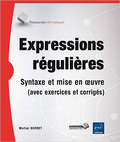GNU/Linux man pages
Livre :
Expressions régulières,
Syntaxe et mise en oeuvre :


Unix |
Unix v7 |
|
 |
diff3(1) |
 |
diff3 − 3-way differential file comparison
diff3 [ −ex3 ] file1 file2 file3
Diff3 compares three versions of a file, and publishes disagreeing ranges of text flagged with these codes:
|
==== |
all three files differ |
|||
|
====1 |
file1 is different |
|||
|
====2 |
file2 is different |
|||
|
====3 |
file3 is different |
The type of change suffered in converting a given range of a given file to some other is indicated in one of these ways:
|
f : n1 a |
Text is to be appended after line number n1 in file f, where f = 1, 2, or 3. | ||
|
f : n1 , n2 c |
Text is to be changed in the range line n1 to line n2. If n1 = n2, the range may be abbreviated to n1. |
The original contents of the range follows immediately after a c indication. When the contents of two files are identical, the contents of the lower-numbered file is suppressed.
Under the −e option, diff3 publishes a script for the editor ed that will incorporate into file1 all changes between file2 and file3, i.e. the changes that normally would be flagged ==== and ====3. Option −x (−3) produces a script to incorporate only changes flagged ==== (====3). The following command will apply the resulting script to ’file1’.
(cat script; echo ´1,$p´) ⎪ ed − file1
/tmp/d3?????
/usr/lib/diff3
diff(1)
Text lines that
consist of a single ’.’ will defeat
−e.
Files longer than 64K bytes won’t work.
 |
diff3(1) |  |